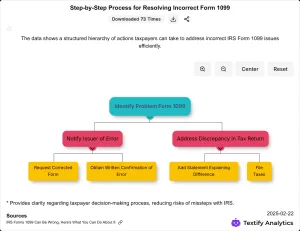W-9 vs 1099: Key Differences Every Business Must Know in 2025

When you run a small business, it is important to handle taxes correctly. This is especially true when you work with independent contractors or manage payments you receive. Two essential forms in this process are the W-9 and 1099 forms. This blog will be on W-9 vs 1099, their purpose, differences and more.
While they work together in the tax reporting chain, they serve distinctly different purposes. Let’s explore the 5 main differences between IRS Forms W-9 and 1099. This will help you stay organized and compliant for your income tax return.
W-9 vs 1099: Purpose (Information Collection vs. Income Reporting)
• W-9 Form: The W-9 is an information collection tax form. An independent contractor typically provides it to a business before work begins.
The form gathers key information. This includes the contractor’s name, address, Social Security Number (SSN), and Employer Identification Number (EIN). This ensures the hiring business has accurate information to report payments to the IRS later.
• 1099 Form (e.g., Form 1099-NEC): A 1099 form is an income reporting form. Businesses issue this form to independent contractors and the IRS, summarizing how much they received payments throughout the year. The most commonly used version for contractors is Form 1099-NEC (Non-employee Compensation), which replaced 1099-MISC for reporting service payments.
Key takeaway: Use the W-9 to collect taxpayer information, and the 1099 to report income after making payments.
Who Fills Out the Form?
W-9: The contractor or freelancer fills out the W-9 form and submits it to the business hiring them — not the IRS. The business keeps the form for records, using it when preparing Form 1099 later.
• 1099: The hiring business fills out and sends Form 1099-NEC to both the IRS and the contractor by the due date — typically January 31st of the following year.
Key takeaway: Contractors fill out W-9s; businesses prepare and send 1099s.
W-9 vs 1099: When the Forms Are Used
• W-9: This form is provided before work starts or when a business first engages an independent contractor. Collecting correct taxpayer information from the start is a proactive step, preventing issues later on.
• 1099: This form is issued after the contractor receives $600 or more in non-employee compensation during the tax year. If total payments total less than $600, you do not need a 1099. However, the contractor must still report this income on their tax return.
Key takeaway: Complete the W-9 before starting work; the company issues the 1099 after totaling the year’s payments.
W-9 vs 1099: Tax Withholding Differences
• W-9: Usually, contractors do not have any tax taken out when they submit a W-9. This is true if they confirm they are not subject to backup withholding. Backup withholding is usually 24%. It only occurs if the contractor does not provide a valid Social Security Number or Taxpayer Identification Number (TIN).
• 1099: A 1099 form only reports income; it doesn’t handle withholding for independent contractors. Contractors are responsible for setting aside money for income tax, self-employment tax, and Social Security on their own.
Key takeaway: The W-9 form shows if you need backup withholding. The 1099 form reports income without withholding taxes.
Industries and Situations Where They Apply
• W-9: Common in industries that frequently work with independent contractors, such as real estate, creative services, consulting, and more. Landlords may also request a W-9 from tenants for tax reporting on rental income.
• 1099: Issued in various situations, including:
- Payments to freelancers or contractors
- Real estate transactions (e.g., Form 1099-S for sale proceeds)
- Interest income, dividends, and other non-wage income sources
Key takeaway: Many industries use the W-9 form to collect information. The system provides the 1099 form when reportable payments occur, especially for independent contractors.
Avoiding Common Mistakes with W-9 and 1099 Forms
One of the biggest mistakes small businesses make is waiting until tax season to collect W-9s. They may also realize too late that someone did not issue a 1099 form on time. This can lead to penalties from the IRS, inaccurate reporting, and even backup withholding obligations.
To avoid these problems, businesses should include the W-9 in the onboarding process for independent contractors. They should collect it before making any payments. Checking that the Social Security Number (SSN) or Taxpayer Identification Number (TIN) is correct is important. This helps reduce the risk of errors when filing Form 1099-NEC.
Keeping organized records of all payments received during the year is important. It helps make preparing and filing 1099s faster and more accurate.

Understanding the Bigger Tax Picture
For independent contractors, getting a 1099 form means the IRS knows about their payments. This means they must report this income on their tax return. Unlike regular employees, contractors must pay their own income tax, Social Security, and Medicare taxes.
They usually do this through quarterly estimated payments. This means contractors should save some of their earnings during the year. This helps them avoid a large tax bill or penalties when they file.
Businesses gain from issuing 1099s. You can deduct these payments as business expenses. This reduces the company’s overall taxable income.
Handling W-9s and 1099s correctly helps both parties follow the rules. It also ensures clear and accurate tax reporting.
This is important in real estate. Significant transactions happen often in this industry. The IRS pays close attention to these transactions.
Also Read: Standard Deductions: How to Maximize Your Tax Return Savings
Penalties and Compliance Risks
The IRS takes tax reporting seriously — and small businesses that overlook W-9 and 1099 requirements could face costly consequences. If a business does not send Form 1099-NEC to an independent contractor by the due date, there are penalties. The due date is usually January 31st of the next year.
The amount of the fine depends on how late the form is submitted:
• $60 per form — If filed within 30 days after the deadline.
• $120 per form — If filed more than 30 days late but before August 1st.
• $310 per form — If filed after August 1st or not filed at all.
– Intentional disregard penalty: If businesses choose not to file, the IRS will charge a fine.
– The fine is at least $630 for each form. No maximum limit exists for this penalty.
For example, if a small business forgets to issue 10 contractor 1099-NECs and notices this after August 1st, they could get a $3,100 fine. This is a big hit for a growing company.
The Backup Withholding Trap
The penalties don’t stop with late or missing forms. If a business does not collect a W-9 from a contractor, it can face issues. If the IRS decides that backup withholding should have happened, the business must pay the unpaid taxes. This is true even if the contractor reported the income on their tax return.
Backup withholding, currently set at 24%, is required when:
• The contractor fails to provide a Social Security Number (SSN) or Taxpayer Identification Number (TIN).
• The IRS notifies the business that the contractor’s TIN is incorrect or invalid.
• The contractor hasn’t certified on the W-9 that they’re exempt from backup withholding.
Let’s say a business hires a freelancer for $10,000 in services but doesn’t collect a W-9 beforehand. If the IRS decides that the business needs to implement backup withholding, the business might owe $2,400 in taxes. This can happen even if the contractor got the full payment and paid their own taxes correctly. This creates a double-taxation scenario where both the contractor and the business suffer financial loss.
Getting a completed W-9 form in advance helps avoid costly mistakes. It ensures accurate records and protects the business from unexpected tax bills.
Protecting Your Business: Best Practices
To avoid penalties, small businesses should:
1. Collect W-9s early: Make the W-9 part of your onboarding process for contractors. Don’t wait until the year ends — collect it before the first payment.
2.Verify information: Cross-check the contractor’s SSN or TIN to catch errors early. Consider using IRS TIN matching services to confirm accuracy.
3.Track payments: Keep a running total of received payments to each contractor. The IRS requires a 1099-NEC for payments totaling $600 or more in a year — staying organized prevents missed filings.
4. Meet the Deadlines: Mark January 31st on your calendar. This is the final date to send 1099 forms to contractors and the IRS.
5.Secure your records: Keep W-9s and 1099s for at least 4 years. These forms are crucial if the IRS audits your business.
By focusing on compliance and keeping good records, small businesses can avoid substantial fines. They can also stay in the IRS’s good graces and make tax reporting easier.
Why Both Forms Matter for Small Businesses
For small businesses that hire independent contractors or manage real estate, handling W-9 and 1099 forms is essential. Collecting W-9s early helps you avoid tax problems later. Issuing 1099 forms on time keeps you in line with IRS rules and helps you avoid penalties.
Mark your calendar for the due date — January 31st — to send out Form 1099-NEC. And remember: while you won’t send W-9s to the IRS, you must store them securely for future reference in case of an audit.
Would you rather stay focused on growing your business instead of navigating complex tax paperwork? Think about using accounting software or hiring a professional to prepare your income tax return. This can help you stay compliant and stress-free.